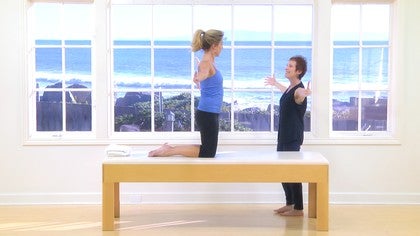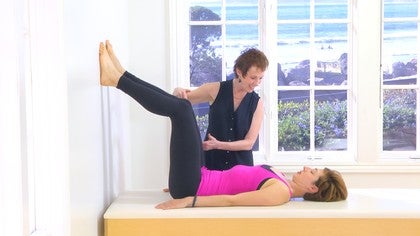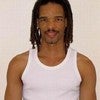Description
About This Video
Transcript
Read Full Transcript
I want to share with you a series that I learned from Eve gentry that I've played with a lot over the years. And the more I do it, the more it reveals itself to me. Um, we'll just get started and feel free to come along with us as we go. So go ahead and come onto your knees. Do your best to have your wrists lined up underneath of your shoulders, your knees underneath your hips, and then just as best as you can, your legs, your four legs straight out behind you. So right at the beginning, we're just going to do an exercise that we call the pregnant cat. So keeping your spine in its natural state as you breathe in, you're going to allow your abdominals to let go down.
And then on your exhalation you're going to draw them in, but not change your spine at all. Very good. So as you inhale, let the abdominals go down and feel the support for your spine. Exhale, draw them back in coming from the four limbs. Okay. So the strength of the connection from your hand up your arm into your shoulder girdle, helping to support the weight of your trunk, your thorax, and then the strength of the legs coming up into the hips, helping to hold the support at the pelvis one more time and with the breath.
And then as you exhale, keep exhaling, keep exhaling, keep exhaling, keep exhaling, and draws close into center as you can without changing the spine. This is really, really good for training you to use your abdominals to support your spine, but not pushing into your back, not pushing yourself into flection. So we kind of cut through that habit of every time we draw the abdominals in, we have to push our back up, but it's a much more, well, it's a well rounded action of the abdominals. Okay, so now we're going to go into our spinal series. As you inhale, think of lengthening as much as you can from the top of your head to the tip of your tail. And then exhale, start to curl the head in, roll through your spine, and then bring the head and tail is close to one another as possible. As you inhale, start stretching your pubic bone away from your navel. Come back toward the middle range, and then as you exhale, keep going into extension. But again, keep your focus on the top of the head and the tip of the tail.
Inhaling, reach the pubic bone toward the naval, dropping the tail ripple through your spine. And on the exhale come to the biggest flection you can. Inhale, reach the pubic bone away from the navel, lengthening out through the top of the head. Exhale into extension. Keep the focus on the strength through the limbs. One more time in with the breath.
Start to go through neutral and exhale and deflection. So this is cat cow, all gray mayors, what you've called it, make sure that you don't shift off of your legs, but you keep the weight as much as you can in the arms and the legs. And the only difference here really is that instead of the focus being this area as the leverage, you're actually trying to work the whole head tail the whole time. So let me show you something about that. Come back to the neutral position and then literally pushed gently into me and then reach into me and then just shift your weight back and forth a few times.
Head tail, head tail, and feel the potential for your spine is, uh, as a hollow channel through your body. And then as you make this connection from your head to your tail, it just goes through. It doesn't have to take any detours. So again, like we've talked about, it doesn't go into you, it goes through you, right? And then it's just a very nice way to actually test for yourself. Do I have the tendency to sit back and my hips? Do I have the tendency to hunch over my shoulders or can I find that nice balance between the two? So let's do the cat cow or the old gray mare.
One more time. Take a nice breath in. And as you exhale, take the pubic bone toward the Navel, drop the tail, and take the top of the head down. So in your mind you're really thinking the very ends. And now inhale, reach the pubic bone, stretch it away. You can feel how it releases you into your hips, right? And gives you the room to keep extending your spine. Good. Come back to the center and really put weight in your arms and really rely on the strength of that connectivity through your hand, through your arm, which connects into your shoulder girdle, which holds up your rib cage, which holds up your spine in this instance to keep you from overleveraging off that sacrum Lumbar junction. Okay, so the next one is called old gray mare. This is our side then.
So take a breath in. Feel this link all the way from the top of the head to the tail. And as you exhale, bring your right hip towards your right shoulder and look over your right shoulder. This is a er who's looking for his lost tail. And as you inhale, lengthen the and the head away from one another again and exhale come the other way. Good. Couple more times. Inhale, lengthen the tail. Keep using the strength of the arm to keep you from collapsing down into your shoulder girdle. Inhale as you come through the center. Exhale, and one of the points that you want to pay attention to on this one if you could go a couple more times, is that you maintain the weight on both legs.
There's going to be a tendency to pull off when you go to the opposite side, so just check in as you try this. As you look over your left shoulder, you maintain the weight equally on the legs. You don't pitch yourself into the right hip, okay? A lot of what you find as you do these is we have a tendency to, I wouldn't want to say overwork, but do a majority of the motion down here through the lumbar spine. And what I've been finding is that the more we can really strengthen the arms and use this support from the hand through the arm, up into the shoulder, the shoulder girdle, into the balance and support of the rib cage.
This really has an impact on how we do extension and extension is, is tricky for people. Okay, so let's look at that one one more time. The old gray mare. So you take a breath. As you exhale, you look to one shoulder and you pull that hip around, but keep pushing with your arms to suspend rib cage. And there you go. Christie. Feel how you can get a little bit more lateral rotation. That's because you're not collapsing. Yeah, and you're getting the support from the front of your body too. Okay, so breathe in as you come to the middle. Exhale. Come on over here to me.
Keep the, yeah, see there's a tendency to sit back, right? If you literally can keep your weight a little, sorry I took it too far. But if you can keep that weight on the arms and keep using the strength, that's it. You're going to start to get a lot more mobility and tone through this upper, so that's really good for the breath. The support, and like I said, it's going to aid in your extension in general. Okay, so number three is called the lion drinking. And again, this is primarily focused on the area around the shoulder girdle. So for this one, turn your fingertips toward the middle so they'll face one another. Okay, so true to eve, we breathe in first.
On Your exhalation, you simultaneously bend the elbows, but draw the shoulder blades together. You're going to lower your chest down to the ground and this is your pond, so lion drinking. So you bring your mouth down toward the floor and you focus on the squeeze, particularly through the upper part of your shoulder blade. At this point you take a breath, that's your drink and then exhale simultaneously. Slide those blades apart as you press off the hand.
Arm, shoulder grade blade, rib cage connection, and you come into the deepest upper spinal flection. You can get so right in through that part between the shoulder blades. That's so hard for us to get at. And then breathe into that space. Exhale simultaneously. Bend the elbows, drawing the shoulder blades together, aiming your face to the, to the floor. Take a breath here. Exhale, widen the shoulder blades, press through the whole hand, the whole arms. Strengthen those arms to push you up.
Great job. Inhale into that space. Exhale, squeeze the blades as you pull and reach your arms out to the sides. There you go. Here's that upper back. Here's the support for the neck. Here's the part of our spines. We have so much trouble getting into, especially in extension. And then last time, let the blades come apart. Press off the palm, the whole palm, and then come as high up into that upper curl as you can. Isn't that beautiful? And do you feel how when you get that suspension, how light your legs are? You could almost, you could try this if you want, you could press into your feet, right? And lift your knees up. Yes. And you're completely suspended and your legs don't weigh a thing. Okay, go ahead and lower them down.
Come back to the neutral position and bring your hands straight forward again. So now we're going to go into the thread, the needle. Okay. And again, there's a tendency to shift back and forth into the lower body and do the majority of the work in the lumbar. And what you're really looking for. It's hard, it's hard to get it, but we want to get this mobility through the thorax. So take a breath in here and on your exhale, raise your right arm up towards the ceiling. That's it. And now feel the support from the underside of your left blade.
You see that blade is coming around and helping to lift you while the right shoulder blade is coming into the spine and strengthening the muscles that are actually going to open up your chest. Right? And now breathe in. It's as if somebody came and lifted you up. You see? So you, so you use this arm literally to push you up. You're not getting stuck in the wrist and the shoulder. And then threading the needle. Here we go. Exhaling, come through. If you can get your whole ear to the mat, it's really, really nice.
And then you can see if you take an extra breath, how you can pull that arm just a little further on the breath and get this wonderful upper spinal twist. Right elbow to knee saw corkscrew all our twists on your next exhale. Push down through the top arm to free your chest. Come on up. Exhaling all the way to the ceiling. We'll go a little faster this time I'm taking you a little too slow.
Really Inhale, lift. Exhale. Come through. Good. See if you can release your ear to the Mat. Take a breath in. Keep rotating. Good job, Huh? And then last time, push off your right hand. Try not to try not to go away from it.
Yes. Beautiful. Yes. Okay. And then let, I think we better do one on the other side. Just one or two. Okay. Okay. So take a breath in and as you exhale, you're going to reach the left arm up. Feel the relationship between your two sides. Feel the one blade coming around and the arms strong. Breathe at the top as if somebody lifted and pulled you and freed you. Exhale, come through. Now it's the opposite movement of the shoulder blade, the underneath blade. It is, it is. It's hard.
Take a breath and then go a little farther. There you go. And there's a little sticky, Huh? And then inhale. Yeah. Exhale, press down. So there we go. That's how you're gonna build this strength. What we all want to do is pull away from it and sit back in our hips. And this is great if you can avoid doing that.
All right, last time, breathe in and exhale. Press down through that right arm. Reach the left arm up and up and up. And then bring yourself, actually, let's do this. We're going to improvise. Now. Reach the arms so much up. It picks your other arm up and just come to kneeling. Just come to kneeling. Okay. Take your arms out to the sides.
Feel the spread across your chest feels like equal with over your horizontals. So from collarbone all the way out to thumb and shoulder blade, all the way out to little finger and peel those fingers back and just see how far back you can take those arms. Feel the shoulder blade starting to rotate and not push your spine so much forward as what they're doing is they're taking the muscles to pick your spine up. You feel that you feel that freedom in your hips, right? So it's not that far to actually just take your hands back right into Cammo. Could you imagine, right? There you are. You see how close your heels are.
Hold onto those heels and feel the power of the hand to the arm, to the shoulder blade, to the chest. Right. Okay. And then go ahead and come back up and release yourself now onto your belly. Okay, so we might use this talent a couple of minutes, but I'm just [inaudible] taking it off to the side for now. So come into your like kind of a low sphinx comfortable position where your arms are not so close to you that you have any concern about any tenderness in your lower back. You should feel comfortable. And I want to revisit the spinal wave. We've done it a lot now.
We've done it on our back. We've had a lot of opportunities to do our spinal wave. How I want to show you how it can help you in extension. Okay. So why don't you to go ahead and breathe in and tilt your pubic bone towards your navel and let your head come down. Don't go yet. And now exhale, release it.
Stretch your pubic bone away from your navel and stretch your nose away from your navel. Reach the pubic bone toward the navel. That's it. So you can feel how you're not overworking your back. And now as you release and stretch the pubic bone away from the navel, is there a different quality in the front of your hips than just dropping into your lumbar spine? Great. One more time. Pubic bone to navel and they'll start the release at the pubic bone.
And see if you can get to the top and get back into your wave curl and then release pubic bone away. That's it. Does not feel good and curl. Feel the lift of the upper spine, giving you the room to get the stretch. And then the release to open into extension. One more in the, I'm gonna add something cause you look so good this time as you begin to stretch your pubic bone away from the navel. Bend your knees.
Yup. It's easy, right? Because your hips are open. And now curl the pubic bone toward the naval to lengthen your legs. Reach it away as you bend your knees. So get the wave as now part of the leg movement. Beautiful. Yes. Okay, so now I'm going to sneak this towel. When you bend your knees, I'm going to sneak this towel under you so that, yeah.
So we have plenty of college because I think this mat is sticky. Yes. All right. So I made this up in a way. I call it the SLURP. Okay. So you're going to start to stretch that pubic bone up toward the belly button so much. And come all the way through your upper spine that it curls you so much that it lets you in draws those legs right underneath you.
Now use the strength of pressing off your arms, hand, arm, shoulder, rib cage, spine, and now stretch your pubic bone away from your belly button and come into that extension. Create the wave curl. Use the strength of the lift of your upper spine in your arms to pull you through and last time slide away and come up into extension. And that sets you up very nicely, doesn't it, for all your single and double leg kick. Okay. Do you feel free? Excellent. That's great. Okay, so a lot of the work that we do with our upper body eye, we don't realize necessarily how much these kinds of supports that strengthen these muscles are part and parcel of what we're missing when we go to do extension. You know, when we don't feel our hands, they're right, right? We're focused on the shape where we're focused on making the spine move and really having that memory of what the connection of the arm into the girdle can really do for us. So lots of thorax, lots of mobility in each direction in the thorax is really gonna support you.
Lots of rotation. Yeah. That's great. Okay. Thank you. Thank you.
Mindful Movement: Transitional Moments
Comments
You can be creative and change the angle of the series to take pressure of the wrist; even so far as to be upright against a wall, or corner, coming down the wall as is possible. One can kneel in front of a chair and place the forearms on the chair seat, (this may reveal shoulder tightness) or you could use the cadillac poles and if you have a slider bar then you have many choices of height. There are also various wedges available to take the pressure off the wrist. Thanks for your feedback and let me know how it goes! Debora
For the record, the side to side motion is called, "Donkey Wags", not "Old Grey Mare" which is the flex/extend variation. Hence the reference to Eeyore, the donkey from "Winnie The Pooh"
You need to be a subscriber to post a comment.
Please Log In or Create an Account to start your free trial.





















